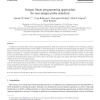Free Online Productivity Tools
i2Speak
i2Symbol
i2OCR
iTex2Img
iWeb2Print
iWeb2Shot
i2Type
iPdf2Split
iPdf2Merge
i2Bopomofo
i2Arabic
i2Style
i2Image
i2PDF
iLatex2Rtf
Sci2ools
DAM
2007
2007
Integer linear programming approaches for non-unique probe selection
In addition to their prevalent use for analyzing gene expression, DNA microarrays are an efficient tool for biological, medical, and industrial applications because of their ability to assess the presence or absence of biological agents, the targets, in a sample. Given a collection of genetic sequences of targets one faces the challenge of finding short oligonucleotides, the probes, which allow detection of targets in a sample by hybridization experiments. The experiments are conducted using either unique or non-unique probes, and the problem at hand is to compute a minimal design, i.e., a minimal set of probes that allows to infer the targets in the sample from the hybridization results. If we allow to test for more than one target in the sample, the design of the probe set becomes difficult in the case of non-unique probes. Building upon previous work on group testing for microarrays we describe the first approach to select a minimal probe set for the case of non-unique probes i...
| Added | 13 Dec 2010 |
| Updated | 13 Dec 2010 |
| Type | Journal |
| Year | 2007 |
| Where | DAM |
| Authors | Gunnar W. Klau, Sven Rahmann, Alexander Schliep, Martin Vingron, Knut Reinert |
Comments (0)

